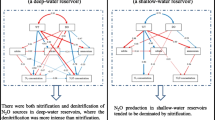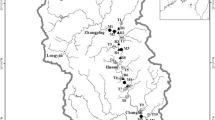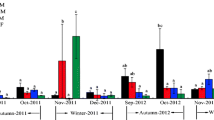Abstract
Aquatic ecosystems have been identified as a globally significant source of nitrous oxide (N2O) due to continuous active nitrogen involvement, but the processes and influencing factors that control N2O production are still poorly understood, especially in reservoirs. For that, monthly N2O variations were monitored in Dongfeng reservoir (DFR) with a mesotrophic condition. The dissolved N2O concentration in DFR displayed a distinct spatial–temporal pattern but lower than that in the eutrophic reservoirs. During the whole sampling year, N2O saturation ranging from 144% to 640%, indicating that reservoir acted as source of atmospheric N2O. N2O production is induced by the introduction of nitrogen (NO3 −, NH4 +) in mesotrophic reservoirs, and is also affected by oxygen level and water temperature. Nitrification was the predominate process for N2O production in DFR due to well-oxygenated longitudinal water layers. Mean values of estimated N2O flux from the air–water interface averaged 0.19 µmol m−2 h−1 with a range of 0.01–0.61 µmol m−2 h−1. DFR exhibited less N2O emission flux than that reported in a nearby eutrophic reservoir, but still acted as a moderate N2O source compared with other reservoirs and lakes worldwide. Annual emissions from the water–air interface of DFR were estimated to be 0.32 × 105 mol N–N2O, while N2O degassing from releasing water behind the dam during power generation was nearly five times greater. Hence, N2O degassing behind the dam should be taken into account for estimation of N2O emissions from artificial reservoirs, an omission that historically has probably resulted in underestimates. IPCC methodology should consider more specifically N2O emission estimation in aquatic ecosystems, especially in reservoirs, the default EF5 model will lead to an overestimation.








Similar content being viewed by others
References
Baulch HM, Schiff Sherry L, Maranger R, Dillon Peter J (2012) Testing models of aquatic N2O flux for inland waters. Can J Fish Aquat Sci 69:145–160
Beaulieu JJ, Tank JL, Hamilton SK, Wollheim WM, Hall RO, Mulholland PJ, Peterson BJ, Ashkenas LR, Cooper LW, Dahm CN, Dodds WK, Grimm NB, Johnson SL, McDowell WH, Poole GC, Valett HM, Arango CP, Bernot MJ, Burgin AJ, Crenshaw CL, Helton AM, Johnson LT, O’Brien JM, Potter JD, Sheibley RW, Sobota DJ, Thomas SM (2011) Nitrous oxide emission from denitrification in stream and river networks. Proc Natl Acad Sci USA 108:214–219
Beaulieu JJ, Smolenski RL, Nietch CT, Townsend-Small A, Elovitz MS, Schubauer-Berigan JP (2014) Denitrification alternates between a source and sink of nitrous oxide in the hypolimnion of a thermally stratified reservoir. Limnol Oceanogr 59:495–506
Beaulieu JJ, Nietch CT, Young JL (2015) Controls on nitrous oxide production and consumption in reservoirs of the Ohio River Basin. J Geophys Res Biogeosci 120:1995–2010
Clough TJ, Buckthought LE, Kelliher FM, Sherlock RR (2007) Diurnal fluctuations of dissolved nitrous oxide (N2O) concentrations and estimates of N2O emissions from a spring-fed river: implications for IPCC methodology. Glob Change Biol 13:1016–1027
Deemer BR, Harrison JA, Whitling EW (2011) Microbial dinitrogen and nitrous oxide production in a small eutrophic reservoir: an in situ approach to quantifying hypolimnetic process rates. Limnol Oceanogr 56:1189–1199
Emerson S (1975) Chemically enhanced CO2 gas exchange in a eutrophic lake: a general model. Limnol Oceanogr 20:743–753
Fearnside PM (2016) Greenhouse gas emissions from Brazil’s Amazonian hydroelectric dams. Environ Res Lett 11: 011002. doi:10.1088/1748-9326/11/1/011002
Fearnside PM, Pueyo S (2012) Greenhouse-gas emissions from tropical dams. Nature Clim Change 2:382–384
Guerin F, Abril G, Tremblay A, Delmas R (2008) Nitrous oxide emissions from tropical hydroelectric reservoirs. Geophys Res Lett 35:L06404. doi:10.1029/2007GL033057
Han G, Tang Y, Xu Z (2010) Fluvial geochemistry of rivers draining karst terrain in Southwest China. J Asian Earth Sci 38:65–75
Hendzel LL, Matthews CJD, Venkiteswaran JJ, Louis VLS, Burton D, Joyce EM, Bodaly RA (2005) Nitrous oxide fluxes in three experimental boreal forest reservoirs. Environ Sci Technol 39:4353–4360
Hinshaw SE, Dahlgren RA (2013) Dissolved nitrous oxide concentrations and fluxes from the eutrophic San Joaquin River, California. Environ Sci Technol 47:1313–1322
Hu Y, Cheng H (2013) The urgency of assessing the greenhouse gas budgets of hydroelectric reservoirs in China. Nature Clim Change 3:708–712
Huttunen JT, Vaisanen TS, Hellsten SK, Heikkinen M, Nykanen H, Jungner H, Niskanen A, Virtanen MO, Lindqvist OV, Nenonen OS, Martikainen PJ (2002) Fluxes of CH4, CO2, and N2O in hydroelectric reservoirs Lokka and Porttipahta in the northern boreal zone in Finland. Glob Biogeochem Cycles. doi:10.1029/2000GB001316
Huttunen JT, Juutinen S, Alm J, Larmola T, Hammar T, Silvola J, Martikainen PJ (2003) Nitrous oxide flux to the atmosphere from the littoral zone of a boreal lake. J Geophys Res Atmos 108:4421. doi:10.1029/2002JD002989
IPCC (2006) IPCC guidelines for national greenhouse gas inventories. Prepared by the National Greenhouse Gas Inventory Program. Institute for Global Environmental Strategies, Hayama
Lerman A (1979) Geochemical processes. Water and sediment environments. John Wiley and Sons, Inc., Hoboken
Li SL, Liu CQ, Li J, Liu XL, Chetelat B, Wang BL, Wang FS (2010) Assessment of the sources of nitrate in the Changjiang River, China using a nitrogen and oxygen isotopic approach. Environ Sci Technol 44:1573–1578
Lima Id, Victoria R, Novo E, Feigl B, Ballester M, Ometto J (2002) Methane, carbon dioxide and nitrous oxide emissions from two Amazonian reservoirs during high water table. Internationale Vereinigung fur Theoretische und Angewandte Limnologie Verhandlungen 28:438–442
Liu CQ (2007) Biogeochemical processes and cycling of nutrients in the earth’s surface: chemical erosion and nutrient cycling in Karstic catchments, Southwest China. Science Press, Beijing, p 608 (in Chinese)
Liu XL, Liu CQ, Li SL, Wang FS, Wang BL, Wang ZL (2011a) Spatiotemporal variations of nitrous oxide (N2O) emissions from two reservoirs in SW China. Atmos Environ 45:5458–5468
Liu Y, Zhu R, Ma D, Xu H, Luo Y, Huang T, Sun L (2011b) Temporal and spatial variations of nitrous oxide fluxes from the littoral zones of three alga-rich lakes in coastal Antarctica. Atmos Environ 45:1464–1475
Liu XL, Bai L, Wang ZL, Li J, Yue FJ, Li SL (2015) Nitrous oxide emissions from river network with variable nitrogen loading in Tianjin, China. J Geochem Explor 157:153–161
McCrackin ML, Elser JJ (2011) Greenhouse gas dynamics in lakes receiving atmospheric nitrogen deposition. Glob Biogeochem Cycles 25:GB4005. doi:10.1029/2010GB003897
Mengis M, Gachter R, Wehrli B (1996) Nitrous oxide emissions to the atmosphere from an artificially oxygenated lake. Limnol Oceanogr 41:548–553
Mengis M, Gachter R, Wehrli B (1997) Sources and sinks of nitrous oxide (N2O) in deep lakes. Biogeochemistry 38:281–301
Musenze RS, Fan L, Grinham A, Werner U, Gale D, Udy J, Yuan ZG (2016) Methane dynamics in subtropical freshwater reservoirs and the mediating microbial communities. Biogeochemistry 128:233–255
Nevison C, Butler JH, Elkins JW (2003) Global distribution of N2O and the Delta N2O-AOU yield in the subsurface ocean. Glob Biogeochem Cycles 17:1119. doi:10.1029/2003GB002068
Peng X, Wang B, Liu C, Liu X, Wang F (2012) Diurnal variations of pCO2 in relation to environmental factors in the cascade reservoirs along the Wujiang River, China. Chin J Geochem 31:41–47
Ravishankara AR, Daniel JS, Portmann RW (2009) Nitrous Oxide (N2O): the dominant ozone-depleting substance emitted in the 21st century. Science 326:123–125
Rosenberg DM, McCully P, Pringle CM (2000) Global-scale environmental effects of hydrological alterations: introduction. Bioscience 50:746–751
Sasaki Y, Koba K, Yamamoto M, Makabe A, Ueno Y, Nakagawa M, Toyoda S, Yoshida N, Yoh M (2011) Biogeochemistry of nitrous oxide in Lake Kizaki, Japan, elucidated by nitrous oxide isotopomer analysis. J Geophys Res Biogeosci 116
Satterfield CN (1970) Mass transfer in heterogeneous catalysis. MIT Press, Cambridge
Seitzinger SP, Kroeze C (1998) Global distribution of nitrous oxide production and N inputs in freshwater and coastal marine ecosystems. Global Biogeochem Cycles 12:93–113
Sikar E, Santos M, Matvienko B, Silva M, Rocha C, Santos E, Bentes A, Rosa L (2005) Greenhouse gases and initial findings on the carbon circulation in two reservoirs and their watersheds. Proc Int Assoc Theor Appl Limnol 29:573
Sturm K, Yuan Z, Gibbes B, Werner U, Grinham A (2014) Methane and nitrous oxide sources and emissions in a subtropical freshwater reservoir, South East Queensland, Australia. Biogeosciences 11:5245–5258
Suntharalingam P, Sarmiento JL (2000) Factors governing the oceanic nitrous oxide distribution: simulations with an ocean general circulation model. Global Biogeochem Cycles 14:429–454
Wang SL, Liu CQ, Yeager KM, Wan GJ, Li J, Tao FX, Lue YC, Liu F, Fan CX (2009) The spatial distribution and emission of nitrous oxide (N2O) in a large eutrophic lake in eastern China: anthropogenic effects. Sci Total Environ 407:3330–3337
Wang F, Wang B, Liu C-Q, Wang Y, Guan J, Liu X, Yu Y (2011) Carbon dioxide emission from surface water in cascade reservoirs-river system on the Maotiao River, southwest of China. Atmos Environ 45:3827–3834
Wang SL, Yeager K, Wan GJ, Liu CQ, Liu F, Lu YC (2015) Dynamics of CO2 in a karst catchment in the southwestern plateau, China. Environ Earth Sci 73:2415–2427
Yu ZJ, Deng HG, Wang DQ, Ye MW, Tan YJ, Li YJ, Chen ZL, Xu SY (2013) Nitrous oxide emissions in the Shanghai river network: implications for the effects of urban sewage and IPCC methodology. Glob Change Biol 19:2999–3010
Zhu D, Chen H, Yuan X, Wu N, Gao Y, Wu Y, Zhang Y, Peng C, Qa Zhu, Yang G, Wu J (2013) Nitrous oxide emissions from the surface of the Three Gorges Reservoir. Ecol Eng 60:150–154
Acknowledgements
This study was financially supported by the National Key Research and Development Program of China through grant 2016YFA0601000; the National Major Scientific Research Program Grant No. 2013CB956401; the National Natural Science Foundation of China through Grants Nos. 41325010, 41403082, and 41302285; and the Tianjin Research Program of Application Foundation and Advanced Technology Grant No. 14JCQNJC08800. We are grateful to Shi-Lu Wang, Ning An, and anonymous reviewers for valuable comments and suggestions on this manuscript.
Author information
Authors and Affiliations
Corresponding authors
Ethics declarations
Conflict of interest
The authors declare that they have no conflicts of interest to this work. We declare that we do not have any commercial or associative interest that represents a conflict of interest in connection with the work submitted.
Rights and permissions
About this article
Cite this article
Liu, X., Li, S., Wang, Z. et al. Nitrous oxide (N2O) emissions from a mesotrophic reservoir on the Wujiang River, southwest China. Acta Geochim 36, 667–679 (2017). https://doi.org/10.1007/s11631-017-0172-4
Received:
Revised:
Accepted:
Published:
Issue Date:
DOI: https://doi.org/10.1007/s11631-017-0172-4




